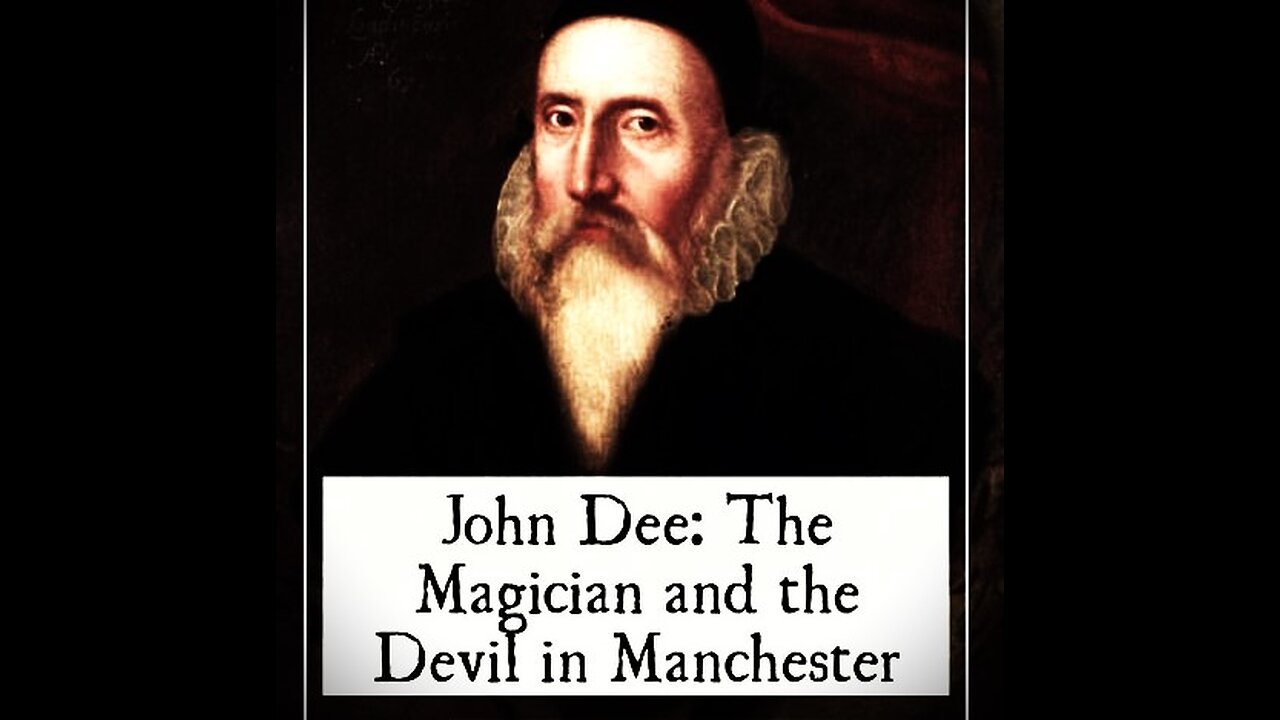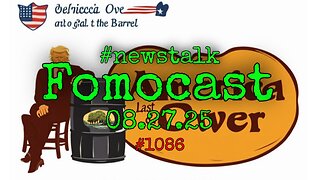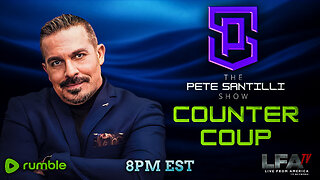Premium Only Content

John Dee: The Magician and the Devil in Manchester
John Dee: The Magician and the Devil in Manchester
What does an Elizabethan mathematician, a northern pre-industrial town, and Beelzebub have in common? Answer? They all appear in the tale of John Dee and the Devil in Manchester.
Dee, immortalized in the opera Dr Dee by Blur’s Damon Albarn, is a fascinating figure in Britain’s occult history. He even inspired a deck of oracle cards, The Oracle of Dr John Dee (aff link).
So without further ado, let’s pop back to the late sixteenth century and find out how Dee and the Devil met up in a library…
As ever, hit play below to listen to the podcast episode! Or keep reading…
Who was John Dee?
Born in 1527, John Dee became an advisor to Queen Elizabeth I. He was also Queen Mary’s astrologer, an astronomer, mathematician, and philosopher. You could see him as being a bit of a polymath. He saw each of these ‘sciences’ as a means to reach God.
A 16th-century portrait of John Dee.16th century portrait of Portrait of John Dee. Ashmolean Museum [Public domain], via Wikimedia Commons
In those days, people treated astrology like a science. They drew up charts for all sorts of events to see how they might go. You might draw your chart to see when the best time would be to hold a coronation or a wedding. None of this cheap newspaper nonsense for the Tudors! Nowadays, you can find your own birth chart online on sites like Astro.com.
Strangely, Dee still managed to draw up astrological charts for Elizabeth, despite the dangers of doing so. As Ruth Volter points out, “[i]n 1581, an Act also established the death penalty for any kind of prophesying and soothsaying regarding the Queen’s reign with the help of occult practices and witchcraft” (2017: 110).
Dee was also a magician.
This is not the same thing as being a witch or a cunning man. Magicians were more ceremonial, following prescribed rituals. As Jason Louv notes, Dee was being a scientist in these endeavors. Nowadays, science is about testing theories and running experiments.
But in Dee’s day, science kept looking backwards to rediscover the knowledge lost during the Dark Ages (Louv 2018: 7). Ideally, you’d work your way backwards to God himself to get wisdom for the original source. It’s still seeking knowledge, just in a different way. Louv points out that a lot of biographers have skimmed over or been downright disdainful of Dee’s occult work (2018: 3). Conversely, other writers elevate Dee’s angelic work and romanticize these activities.
An image of John Dee's clairvoyance crystal.John Dee’s crystal, supposedly given to him in November 1582 by the angel Uriel, used for clairvoyance & healing. By Wellcome Images [CC BY 4.0 (https://creativecommons.org/licenses/by/4.0)]
Dee is actually more important than that. The idea of a spiritual dimension populated by good and bad spirits was common in his day. But communication with it was restricted to the Church. Whether you were a cunning man, magician, or a simple scryer, engaging with this realm was not encouraged. The fact that Dee did so – and remained on exceptionally good terms with Elizabeth I – is testament both to his tenacity and the fact he treated his occult endeavours as a scientific enterprise (Louv 2018: 3).
His occult experiments led to his imprisonment for heresy in 1555. Many consider him the inspiration for Prospero in The Tempest. And while we’re talking about his occult work, we really have to introduce his assistant, Edward Kelley. This highly unstable man turned up on his doorstep and claimed the powers of mediumship. (He also claimed to be a necromancer, and you can read more about necromancy here).
An image of John Dee and Edward Kelly raising spirits“Edw[ar]d Kelly, a Magician. in the Act of invoking the Spirit of a Deceased Person.” (1806) By engraved by Ames of Bristol (according to Fincham, Artists and engravers of British and American book plates, 1897), original drawing by Sibly [Public domain], via Wikimedia Commons
Speaking to Angels
Dee and Kelley spent seven years between 1582 and 1589 conversing with angels. Kelley acted as a medium, allowing the angels to speak through him. If you believe Kelley (and there’s plenty of reason not to), the angels passed on “the original language spoken by mankind before the Fall” (Louv 2018: 1). They also gave the pair a hugely complicated maths system to contact angels. Jason Louv explains that this system would later influence the likes of the Rosicrucians, the Golden Dawn, and Aleister Crowley (2018: 2).
I should point out that Kelley also claimed the angels told him he and Dee should share wives. According to Dee’s biographers, Kelley had always had a thing for Dee’s wife. Dee reluctantly went along with it, but if this doesn’t paint Kelley as a cunning, opportunistic charlatan, I don’t know what does.
An image of John Dee's scrying mirror.John Dee’s scrying mirror, by roseandsigil [CC BY 2.0 (https://creativecommons.org/licenses/by/2.0)]
Dee travelled around Europe, even dispensing advice to Rudolf II in Bohemia. Some believe he worked as a spy for Queen Elizabeth. If rumours are to be believed, his code name was (I kid you not) 007. Dee was desperate to be taken seriously and Elizabeth clearly wasn’t going to realise his dream of being appointed court astrologer. His trips to Krakow and Prague look like ill-judged job hunting attempts.
Sadly, locals trashed his house while he was away. He returned to find his home ruined, his books scattered to the four winds, and his occult equipment broken. Dee asked Elizabeth for help – it says a lot about the status this low-born magician managed to achieve if he could speak to the queen himself.
Her solution involved asking the Archbishop of Canterbury to find him a job. While Dee hoped for a position in Winchester, the Archbishop offered him the post of warden at Manchester Collegiate Church. He moved to the city in 1596.
Some of his personal belongings still reside at Chetham’s Library in Manchester.
What’s Chetham’s Library?
Chetham’s Library is the oldest public library in Britain. It dates back to 1653, and houses over 120,000 books, manuscripts, and maps. The original goal was to create a northern rival to the libraries of Cambridge and Oxford. Karl Marx and Friedrich Engels once used its books and you can still see their desk in the reading room.
An image of Chetham's Library in ManchesterChetham’s Library © Icy Sedgwick
The library holds five of his books, including Conrad Gesner’s De remediis secretis. Printed in 1555, Dee wrote Joannes Dee 1556 on its title page. You can see some of the books on the Chetham’s Library website.
So what’s the story about John Dee and Manchester?
He didn’t exactly relish the move but he hoped he could continue his occult studies in relative quiet. Sadly, others at the Collegiate Church treated him with open hostility and he went back to Mortlake in London in 1605.
An image of John Dee performing an experiment for Queen Elizabeth IJohn Dee performing an experiment before Queen Elizabeth I by Henry Gillard Glindoni [CC BY 4.0], via Wikimedia Commons
But before he did, many believe Dee summoned the Devil in the northern city.
This is despite Dee’s fascination for angels, and his unwavering belief he could contact them for guidance. His aim in talking to angels was actually a pretty noble one. He wanted to unify mankind and thought learning the language of creation might help. Some scholars think his interest in maths stems from a similar place – understanding what goes on beneath the world we can see.
For Deborah E. Harkness, “the angels gave Dee the exegetical and restorative tools to read, understand, and rectify the Book of Nature. The angel conversations thus represent Dee’s attempt to practice natural philosophy at a time when many thought that nature, time, and the world as they knew it were approaching their end” (1999: 4).
But back to the demonic end of the spectrum. According to the legend, Dee conjured up Lucifer for his advice. No one knows what advice Old Nick passed on. But a burn mark on a table was allegedly made by one of his hooves.
You can find the table in the Audit Room at Chetham’s School.
Rumours like this fuelled the hatred towards Dee. If that wasn’t enough, plague broke out in the city, killing Dee’s wife and two of his seven children. (Though some sources say he lost four children.)
By this time, Elizabeth I’s death led to the coronation of James I. He denied Dee’s request for a transfer and Dee returned to London in disgrace.
A Royal Conspiracy?
Parliament passed the first Witchcraft Act in 1542, which handed the death penalty to those found guilty of practising witchcraft. Parliament repealed the act in 1547 but restored a new version in 1562.
It’s possible Dee fell foul of James I’s hatred of witches, condensed in the king’s book Daemonologie. The earlier laws only covered dealings with spirits as a crime if it caused actual harm to another person. This made his attempts to contact angels legal since it didn’t involve third parties or injury.
An image of James I of ScotlandJames I of Scotland by John de Critz [Public domain], via Wikimedia Commons
But the 1604 Act meant the death penalty for anyone who invoked evil spirits. Obviously, you could argue angel magic still wouldn’t fall under this bill. Who would claim angels as evil spirits? But given James I’s interest in demonology, Dee still worried about his status. James ignored Dee’s petitions and the bill became law.
It’s a shame Dee fell from grace during his time both in prison and in Europe. Before his imprisonment, he’d amassed an enviable occult library. Most of it disappeared during the ransacking of his house. While some of his documents are viewable online, he remains a shadowy figure in English history.
Dee and the Manchester Psychogeographers
Some believe Dee lived on an old street in the area where the Corn Exchange now stands. Others dispute this, saying it was more likely he lived at the college.
But a note from Dee on August 19, 1597, suggests he received the Earl and Countess of Derby at ‘Alport lodging’. Alport apparently refers to an old village at the end of Deansgate. For those that don’t know Manchester, that’s the opposite end of Deansgate to the Corn Exchange. So it’s possible he had two homes but it’s unlikely one of them was under the Exchange.
Anyway. In February 1996, the Manchester Area Psychogeographic group believed the Corn Exchange was the site of Dee’s former residence. They tried to levitate the building on the anniversary of his arrival in Manchester. The group walked anticlockwise around the Corn Exchange three times, “made a public declaration”, and waited to see if the building moved.
I’m not entirely sure what that was supposed to achieve, either. But you can learn more about psychogeography here.
Summing Up
Either way, John Dee continues to have a hold on the creative imagination of artists and writers alike. While many people focus on his time as the advisor to Elizabeth I, others explore his angelic communications.
He’s even the subject of an artistic ‘conspiracy’. X-rays of the Henry Gillard Glindoni painting above showed a ring of skulls surrounding John Dee. Experts think it shows an ‘airbrushing’ of his magical tendencies.
It’s unlikely that he conjured the devil in Manchester. But the fact the story persists, and that 400 years later, a group of psychogeographers could try to contact his spirit, shows how enduring his legend remains.
Find John Dee as fascinating as I do? I highly recommend The Queen’s Conjuror: The Life and Magic of Dr. Dee: The Science and Magic of Dr. Dee by Benjamin Woollet. You can grab it here on Amazon.
References
Harkness, Deborah E. (1999), John Dee’s Conversations with Angels: Cabala, Alchemy, and the End of Nature, Cambridge: Cambridge University Press.
Louv, Jason (2018), John Dee and the Empire of Angels: Enochian Magick and the Occult Roots of the Modern World, Rochester, Vermont: Inner Traditions.
Voltmer, Rita (2017), ‘The Witch Trials’, in Owen Davies (ed.), The Oxford Illustrated History of Witchcraft and Magic, Oxford: Oxford University Press, pp. 97-133.
-
 LIVE
LIVE
ABD
1 hour agoCyberpunk 2077 | EP 2 - The Opening Act Pt.2 | 4K UHD
31 watching -
 11:11
11:11
Michael Button
9 hours ago $0.25 earnedMy Joe Rogan Experience: Behind the Scenes
3.59K1 -
 LIVE
LIVE
Charlotte Winslow
6 hours agoplaying GTA 5 for the First Time Ever in 2025 | OPEN WORLD WEDNESDAY
151 watching -
 UPCOMING
UPCOMING
Badlands Media
19 hours agoAltered State S3 Ep. 43
11.3K -
 UPCOMING
UPCOMING
FomoTV
5 hours agoAmerica First or Finessed? 🇺🇸 0% Inflation & $9.62 a Week Math | Catholic School Shooting Update | Fomocast 08.27.25
55 -
 LIVE
LIVE
Dragoon_B
3 hours agoDragoon - Counter Strike - Noob to Pro Grind
118 watching -
 8:26
8:26
WhaddoYouMeme
7 hours ago $0.16 earnedThe Internet Lied. He Just Destroyed His Life
3.55K6 -
 46:58
46:58
The Mel K Show
2 hours agoLive Q&A with Mel K 8-27-25
22.7K5 -
 LIVE
LIVE
daniellesmithab
2 hours agoAlberta Next: Lloydminster Town Hall
37 watching -
 LIVE
LIVE
LFA TV
14 hours agoLFA TV ALL DAY STREAM - WEDNESDAY 8/27/25
833 watching